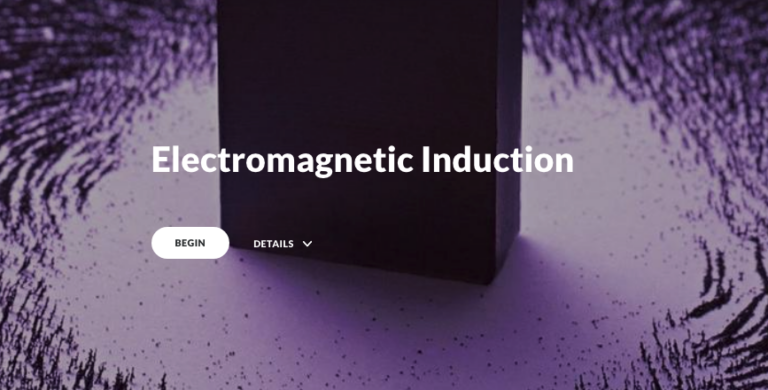In this module, the concepts of electric charge and interacting forces between charges are discussed. This module begins with a brief review of vector notations in both 2-dimension and 3-dimension to aid in the study of electric force vectors. Coulomb’s law is the main focus of the discussion on electric force. The force of repulsion as well as attraction between two point charges is studies first, followed by the discussion of the use of superposition principle in the treatment of net force acting on a point charge due to multiple charges.
Electromagnetics and Circuits
Project Description
This project is a set of 12 learning modules that support the teaching of foundational level electromagnetics and circuits in engineering programs. These modules could be used for an inverted or hybrid delivery of a first year course, or courses. We envision these modules partially or fully replacing in-person lectures, and being paired with in-person laboratories and other hands-on experiential learning activities to create an effective, active learning experience.
Project Components
Electric Fields
The concept of electric field is studies in this module. This module starts by introducing the concepts of electric field and electric field lines. The electric flux is then discussed in reasonable detail, with several examples, leading up to the study of Gauss’ law where the attention is focused on applications of the law by exploring the symmetry in electric field patterns. The module ends on a derivation of electric field strength between a pair of conducting parallel-plate, paving the way for further study of capacitors in subsequent module.
Electric Potential and Potential Energy
The electric potential and electric potential energy are studies in this module. The module begins with an introduction of electric potential energy of a point charge, and then a discussion of the concept of electric potential as a property of the electric field. The concept is further examined through derivations of electric potentials of multiple point charges, sheet charge and non-conducting solid.
Capacitance and Capacitor
Capacitor is the focal point of this module. In this module, a pair of parallel-plates is used to model this electric element, and its capacitance is defined. The various shapes and types (e.g. dielectric) of capacitors are discussed following the same principles found in a parallel-plate capacitor. The energy storing ability of the capacitor is examined as well, and a discussion on how to deal with multiple capacitors in an electric circuit rounds up the materials covered in this module.
Magnetic Fields and Forces
In this module, magnetic forces and fields are studied. The sequence of the discussions is magnetic forces on charge and on current wire, then magnetic field computations using Biot-Savart law, and followed by the introduction of Ampere’s law. In terms of the techniques for calculating magnetic field strength, the emphasis is on applications of Ampere’s law. Magnetic field in and around a straight current wire, magnetic field at the center of a circular current wire, and magnetic field inside a solenoid are carefully analyzed in this module.
Electromagnetic Induction
This module concentrates on study of various concepts in electromagnetic induction, such as magnetic flux, induced emf and induced current in a conducting loop through the introduction to Faraday’s and Lenz’s laws. A derivation illustrating the energy transfer process and the balance of power due to electromagnetic induction is presented as well. Finally, the properties of inductors including inductance, stored energy and equivalent inductance in electric circuits are discussed in the module.
Introduction to Linear Electric Circuits
Physical quantities, basic elements, common terminology and fundamental laws that underlie linear circuit analysis: Ohm’s Law, Kirchoff’s current law and Kirchoff’s voltage law.
Nodal and Mesh Analysis
Systematic methods of circuit analysis based on Kirchoff’s voltage and current laws in the context of analyzing resistive dc circuits.
Circuit Theorems and Equivalent Circuits
The consequences of linearity and equivalence; the use of superposition, source transformations; Thevenin and Norton equivalents applied to circuit analysis.
Operational Amplifier (opamp) Circuits
In this module, the operational amplifier, more commonly called the op amp is introduced and used as a circuit element. While the op amp is not a fundamental circuit element, practical op amps display nearly ideal behaviour, thereby allowing one to construct many useful circuits with relative ease. Consequently, there are two motivations for studying the ideal op amp and common op amp circuits; Firstly, op amp circuits provide practical examples to practice the many circuit analysis techniques learned in the other modules. Secondly, op amps provide an easy way to implement many useful circuits. This module aims to cover the op amp at a level compatible with these two goals.
First Order Step Response
In this module capacitors and inductors are introduced as circuit elements and then the natural and step response of first order circuits are studied. The module has been organized to first provide an introduction to inductors and capacitors as circuit elements. This section of the module can be omitted, if the student is already familiar with the material. The second part covers the natural and step response of simple RC and RL circuits. The results are then extended to general first order RC and RL circuits, by exploiting the student’s knowledge of Thévenin and Norton equivalent circuits an superposition.
Introduction to Sinusoidal Steady-State Analysis
In this module, the analysis of sinusoidally driven circuits and the calculation of ac power is studied. This module begins with a brief analysis of sinusoidally driven circuits in the time domain to illustrate that it is tedious. The Phasor transform and Phasor analysis techniques are then introduced to greatly simplify the analysis of these circuits. The analysis of instantaneous and average power is then introduced with a strong emphasis on sinusoidally driven circuits. Complex power is then introduced along with some Phasor diagrams to illustrate various power relations and their calculations. The main emphasis of the module is on developing the basic tools used in the field.

Project Details
Completed
Copyright/Usage License:
![]() This work is licensed under a Creative Commons Attribution License
This work is licensed under a Creative Commons Attribution License
Funding Information:
This project is made possible with funding by the Government of Ontario and through eCampusOntario’s support of the Virtual Learning Strategy. To learn more about the Virtual Learning Strategy visit: https://vls.ecampusontario.ca



